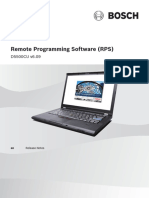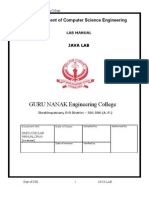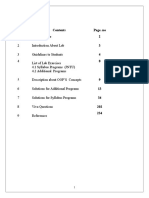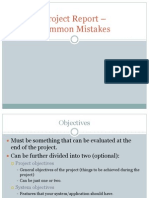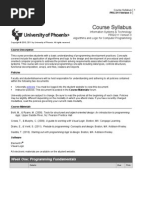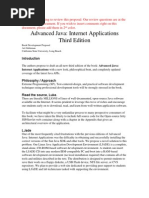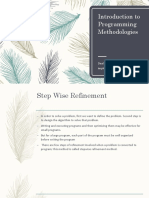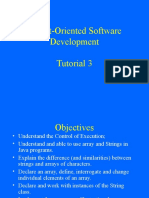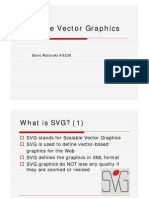Unit: Advanced Programming
Unit: Advanced Programming
Uploaded by
vicrattlehead2013Copyright:
Available Formats
Unit: Advanced Programming
Unit: Advanced Programming
Uploaded by
vicrattlehead2013Original Description:
Original Title
Copyright
Available Formats
Share this document
Did you find this document useful?
Is this content inappropriate?
Copyright:
Available Formats
Unit: Advanced Programming
Unit: Advanced Programming
Uploaded by
vicrattlehead2013Copyright:
Available Formats
Unit: Advanced Programming
Introduction
A computer program is an implementation of a problem specification: we
are given a task and must then design a program to implement this task.
The problem specification is often ambiguous and prone to change -
ensuring consistency and a good methodology for specification
development is part of Software Engineering, which is covered elsewhere.
Our prime concern as a programmer is to develop a detailed plan to tackle
the problem - an algorithm. This algorithm is a high-level description from
which we can generate the program statements. The algorithm is objective
and reflects the programming logic required to achieve the task, while the
specification is simply a broad statement of the problem under review.
Naturally, we wish our program to run as speedily as possible. To this end,
the algorithm that we extract from the specification must be efficient, in
terms of both the time required and memory usage. This requires some
sort of algorithm analysis, in which we examine the performance of our
proposed algorithm using a set of mathematical tools. While the standard
techniques used to accomplish this are not terribly accurate, they do
provide an indication of the utility of the algorithm under a given set of
criteria. Programs manipulate data, so most of the efficiency tests for an
algorithm examine the speed with which it can process data. If we can
construct an analysis of our algorithm, we know how it will perform for very
large amounts of data, and thus whether it is of any use. Imagine an
algorithm which has ``combinatorial complexity'' for N data items: N*(N-
1)*...2*1. For even moderate values of N, say 30 or 40, this value is
enormous. For N=30, we have 1.7*10^98! Any algorithm which requires
this much time or space is of no practical benefit. If our analysis reveals
such a fact, then we have to approach the problem from a different angle
and formulate a new, more efficient, algorithm.
A fundamental component of successful algorithm design is the efficient
manipulation of data. For instance, if you wish to search through a
collection of N data items, the most obvious algorithms may require as
many as N steps (moving from the start of the collection to the end). If you
have a database application, say, with 10^10 records, this means you
would spend a vast amount of time scanning through your data to find the
desired item! Fortunately there are better ways of organising data to
achieve fast and efficient manipulation. A Data Structure is a specific way
of organising data, and the study of different data structures, along with
the algorithms used to manipulate them, forms an important part of
computer science. To write effective and efficient programs, you will need
to familiarise yourself with the standard data structures of computer
science. Simple Data structures such as Lists, Queues and Stacks are
widely used, but are only efficient for a small set of tasks. More powerful
data structures such as Trees and Graphs provide elegant solutions to
many interesting problems, but are more complex and difficult to
implement.
Unit Objectives
• After completing this unit, you will have a good understanding of the
basic data structures of computer science. More specifically, you
should:
• appreciate the issue of algorithm complexity, and its impact on your
programs;
• understand the fundamental data structures and their associated
algorithms;
• have gained some experience in determining which data structures
are appropriate to a given task.
Study
You should expect to spend approximately 9 hours studying this unit.
However, if you have never programmed before you may find that
learning about programming concepts and to program with Java takes
considerable time and you end up taking more than the 9 hours. Often
students find that the more time they invest in studying the basic
principles, as discussed in this unit, the more efficient they become
later. You may find it convenient to break up your study as follows:
Preparation (Introduction and On-line Planning): ½ hour
Disk-based Content: 2¾ hours
Application: 3 hours
Set textbook Content: none
Reflection (On-line discussions, review questions): 1 hour
Tutorial Work: 1 hour
Related Coursework: ¼ hour
Extension Work: ½ hour
Coursework and Exams for Module
The grade for the module is based on coursework (30%) and the final
exam (70%).
Prerequisites for Unit
Completion of the Introduction to Java programming module
Equipment Software Required
A Web browser – for browsing Web sites. All modern popular browsers
should suffice, that is Netscape Navigator 4 (or later version) or
Microsoft Internet Explorer 4 (or later). For many of the practical activities
of this unit, you will :
• Sun Java 2 Platform (also known as Java Development Kit). A
web browser.
• A text editor: For the editing and writing of computer programs.
Windows already provides a simple text editor, called "Notepad"
which is sufficient for editing and viewing Java Programs.
However, you might also like to install an editor designed
especially for working with Java programs and HTML files, such a
product like "TextPad". It is possible to edit Java programs with
powerful word processors, such as Microsoft Word, however you
must be careful to save your programs as text files not in the
normal format for the word processor.
Unit Reading material and resources
M A Weiss, Data Structures & Algorithm Analysis in Java
Addison Wesley
ISBN 0-201-35754-2
This document was created with Win2PDF available at http://www.daneprairie.com.
The unregistered version of Win2PDF is for evaluation or non-commercial use only.
You might also like
- EVS LSM User Manual Ver9Document201 pagesEVS LSM User Manual Ver9gibonulNo ratings yet
- CS261 CourseNotes PDFDocument271 pagesCS261 CourseNotes PDFApril BrownNo ratings yet
- Remote Programming Software (RPS) : D5500CU v6.09Document20 pagesRemote Programming Software (RPS) : D5500CU v6.09westwind347No ratings yet
- Resize Standby Datafile If Disk Runs Out of Space On Standby SiteDocument8 pagesResize Standby Datafile If Disk Runs Out of Space On Standby SitePraveenNo ratings yet
- Chapter 2 - Java Object & DevelopmentDocument67 pagesChapter 2 - Java Object & Developmentvicrattlehead2013No ratings yet
- Javalab ManualDocument58 pagesJavalab ManualTripal MeshramNo ratings yet
- (AP CS A) Semester 1 Project (For Students)Document4 pages(AP CS A) Semester 1 Project (For Students)Ebeb WegNo ratings yet
- ADSA Lab ManualDocument225 pagesADSA Lab ManualjyothibellaryvNo ratings yet
- CS121 Lecture NoteDocument55 pagesCS121 Lecture NoteSalmanu DalhatuNo ratings yet
- ML Projects For Final YearDocument7 pagesML Projects For Final YearAlia KhanNo ratings yet
- Lesson ProperDocument9 pagesLesson Properfaded heartNo ratings yet
- Project Report - Common MistakesDocument11 pagesProject Report - Common Mistakesj.p.reninNo ratings yet
- Java CIS 260 Notes Part 1Document43 pagesJava CIS 260 Notes Part 1fastalan392No ratings yet
- LESSON 2 Algorithm BasicsDocument8 pagesLESSON 2 Algorithm Basicsgraciamark009No ratings yet
- Structure of Programming Languages Module 2 Read OnlyDocument47 pagesStructure of Programming Languages Module 2 Read OnlyZyra MabungaNo ratings yet
- Course Syllabus: Week One: Programming FundamentalsDocument14 pagesCourse Syllabus: Week One: Programming FundamentalsdannyhrglNo ratings yet
- Object Oriented Programming Using Java Final Copy With PedagogyDocument480 pagesObject Oriented Programming Using Java Final Copy With PedagogywerfweNo ratings yet
- Characteristics of Good Comp ProgramDocument2 pagesCharacteristics of Good Comp Programtovilas100% (1)
- MP2: Design PatternsDocument4 pagesMP2: Design PatternsVerguishoNo ratings yet
- AIML ManualDocument76 pagesAIML ManualHardik Kannad100% (1)
- DsdsadDocument4 pagesDsdsadjscansinoNo ratings yet
- CS102 COURSE OUTLINE AUG 2024Document9 pagesCS102 COURSE OUTLINE AUG 2024matarutsetatenda179No ratings yet
- Comp38120 Lab Manual Lab 1Document6 pagesComp38120 Lab Manual Lab 1test12345No ratings yet
- Download full Python for Everyone 2nd Edition Cay Horstmann ebook all chaptersDocument55 pagesDownload full Python for Everyone 2nd Edition Cay Horstmann ebook all chapterscathosslapar100% (1)
- Fundamentals of OOPsDocument19 pagesFundamentals of OOPsBipin BhadraNo ratings yet
- Building Arduino Projects For The Internet of ThingsDocument5 pagesBuilding Arduino Projects For The Internet of Thingssanthosh n prabhuNo ratings yet
- Chapter 06Document19 pagesChapter 06Nhật Thái ĐỗNo ratings yet
- FinalProject DescriptionDocument5 pagesFinalProject DescriptionBhanu ReddyNo ratings yet
- 01-Chap 01-BASIC CONCEPTSDocument48 pages01-Chap 01-BASIC CONCEPTSDinesh KavoorNo ratings yet
- Advanced Java: Internet Applications Third EditionDocument7 pagesAdvanced Java: Internet Applications Third EditionVivek Kumar GuptaNo ratings yet
- MCSL 223 (English)Document84 pagesMCSL 223 (English)Ujjwal BarmanNo ratings yet
- Data Structure and AlgorithmDocument110 pagesData Structure and AlgorithmTariku AyeleNo ratings yet
- The Object-Oriented Thought ProcessDocument19 pagesThe Object-Oriented Thought ProcessRonaldNo ratings yet
- Design and Analysis of AlgorithmDocument85 pagesDesign and Analysis of AlgorithmRemadan MohammedNo ratings yet
- SE - SystemDocument24 pagesSE - SystemTUSHAR NAMANo ratings yet
- Thesis On Java ProgrammingDocument4 pagesThesis On Java Programmingfj8e4mc7100% (2)
- Introduction To Data Structures and Algorithm Analysis: Education For A Fast Changing WorldDocument53 pagesIntroduction To Data Structures and Algorithm Analysis: Education For A Fast Changing WorldtopherskiNo ratings yet
- Lec1 IntroDocument47 pagesLec1 IntroamulyaNo ratings yet
- Programming by HaileDocument24 pagesProgramming by Hailehaile yilma (ETHIOSC)No ratings yet
- Programming Essentials by David. I. ACHEME Is Licensed Under ADocument11 pagesProgramming Essentials by David. I. ACHEME Is Licensed Under AMaire NaragNo ratings yet
- Object Oriented Concepts: o o o oDocument8 pagesObject Oriented Concepts: o o o oDebapriya DandapatNo ratings yet
- Overview of Software Engineering Principles: SCPS311 Lectures SeriesDocument20 pagesOverview of Software Engineering Principles: SCPS311 Lectures SeriesBypass FrpNo ratings yet
- Course Guide in F 32306 Spring 2020Document4 pagesCourse Guide in F 32306 Spring 2020hamidou2010No ratings yet
- Deepercoder: Code Generation Using Machine Learning: NtroductionDocument6 pagesDeepercoder: Code Generation Using Machine Learning: NtroductionDivik ShrivastavaNo ratings yet
- JSP 2 Struts Eclipse 3 DAO ANSI SQL DB and More With ExamplesDocument250 pagesJSP 2 Struts Eclipse 3 DAO ANSI SQL DB and More With Examplesapi-3696230No ratings yet
- Umbrella ActivitiesDocument25 pagesUmbrella ActivitiesYogiPradana100% (1)
- Lesson 1: Introduction To ProgrammingDocument5 pagesLesson 1: Introduction To Programmingdevora aveNo ratings yet
- SEN Micro-ProjectDocument17 pagesSEN Micro-ProjectSahendra VishwakarmNo ratings yet
- Oops Unit 1Document59 pagesOops Unit 1Shruti NarangNo ratings yet
- Creating A ProgramDocument15 pagesCreating A Programr5wch25bqwNo ratings yet
- Creating A Program - RECDocument15 pagesCreating A Program - RECr5wch25bqwNo ratings yet
- Eeee3206-Matlab Programming-2023-2024Document37 pagesEeee3206-Matlab Programming-2023-2024ctenedefomadeNo ratings yet
- Scope of The ProjectDocument36 pagesScope of The ProjectkavetisNo ratings yet
- Software Development Thesis SampleDocument5 pagesSoftware Development Thesis Sampledqaucoikd100% (2)
- History of JavaDocument20 pagesHistory of JavaRithick ChowdhuryNo ratings yet
- Data Structures and Algorithms (Using C++)Document112 pagesData Structures and Algorithms (Using C++)ellen deusNo ratings yet
- All in One OopDocument99 pagesAll in One Oopyaikobdiriba1No ratings yet
- Java ReviewerDocument13 pagesJava ReviewerMarc AbhelNo ratings yet
- Programming Note - 101331Document11 pagesProgramming Note - 101331ademolaagbona olamigokeNo ratings yet
- Software Design Is A Process of Problem Solving and Planning For ADocument5 pagesSoftware Design Is A Process of Problem Solving and Planning For AKirischNo ratings yet
- Introduction To Programming MethodologyDocument48 pagesIntroduction To Programming Methodologysandeep chandranNo ratings yet
- MGM'S: Laboratory ManualDocument34 pagesMGM'S: Laboratory ManualrameshNo ratings yet
- Object-Oriented Software Development - Tutorial 1Document23 pagesObject-Oriented Software Development - Tutorial 1vicrattlehead2013No ratings yet
- Object-Oriented Software Development - Tutorial 3Document32 pagesObject-Oriented Software Development - Tutorial 3vicrattlehead2013No ratings yet
- Object-Oriented Software Development - Tutorial 5Document33 pagesObject-Oriented Software Development - Tutorial 5vicrattlehead2013No ratings yet
- Control Statements: Part 1: Let's All Move One Place OnDocument40 pagesControl Statements: Part 1: Let's All Move One Place Onvicrattlehead2013No ratings yet
- Object-Oriented Software Development - Tutorial 2Document29 pagesObject-Oriented Software Development - Tutorial 2vicrattlehead2013No ratings yet
- Xampp: Manas BapnaDocument11 pagesXampp: Manas Bapnavicrattlehead2013No ratings yet
- Object-Oriented Software Development - Tutorial 4Document20 pagesObject-Oriented Software Development - Tutorial 4vicrattlehead2013No ratings yet
- Control Statements: Part 2: ObjectivesDocument32 pagesControl Statements: Part 2: Objectivesvicrattlehead2013No ratings yet
- jhtp7LM 13Document21 pagesjhtp7LM 13vicrattlehead2013No ratings yet
- Object-Oriented Software Development - Tutorial 6Document31 pagesObject-Oriented Software Development - Tutorial 6vicrattlehead2013No ratings yet
- VB 04Document63 pagesVB 04vicrattlehead2013No ratings yet
- VB 08Document64 pagesVB 08vicrattlehead2013No ratings yet
- Introduction To Classes and Objects: ObjectivesDocument38 pagesIntroduction To Classes and Objects: Objectivesvicrattlehead2013No ratings yet
- VB 06Document50 pagesVB 06vicrattlehead2013No ratings yet
- VB 07Document38 pagesVB 07vicrattlehead2013No ratings yet
- VB 03Document76 pagesVB 03vicrattlehead2013No ratings yet
- VB 01Document45 pagesVB 01vicrattlehead2013No ratings yet
- UNIT 10 - Evaluating The BCS Code of Conduct and The ACM Code of Ethics and Professional ConductDocument16 pagesUNIT 10 - Evaluating The BCS Code of Conduct and The ACM Code of Ethics and Professional Conductvicrattlehead2013No ratings yet
- VB 02Document43 pagesVB 02vicrattlehead2013No ratings yet
- HashingDocument24 pagesHashingvicrattlehead2013No ratings yet
- ATC and AIS AspectsDocument12 pagesATC and AIS Aspectsvicrattlehead2013No ratings yet
- BIS4222 CW Sem 2 02Document6 pagesBIS4222 CW Sem 2 02vicrattlehead2013No ratings yet
- Data Structures and Algorithms: 1 Algorithm Analysis and RecursionDocument37 pagesData Structures and Algorithms: 1 Algorithm Analysis and Recursionvicrattlehead2013No ratings yet
- UNIT 7 - The Social Implications of Artificial Intelligence and Expert SystemsDocument11 pagesUNIT 7 - The Social Implications of Artificial Intelligence and Expert Systemsvicrattlehead2013No ratings yet
- Priority QueuesDocument25 pagesPriority Queuesvicrattlehead2013No ratings yet
- BIS4222 Database Systems: Middlesex UniversityDocument7 pagesBIS4222 Database Systems: Middlesex Universityvicrattlehead2013No ratings yet
- UNIT 4 - Computer Crime: Omputer Heft Nauthorised SE Ccess Odification HE Omputer Isuse CTDocument9 pagesUNIT 4 - Computer Crime: Omputer Heft Nauthorised SE Ccess Odification HE Omputer Isuse CTvicrattlehead2013No ratings yet
- UNIT 6 - PrivacyDocument20 pagesUNIT 6 - Privacyvicrattlehead2013No ratings yet
- UNIT 8 - Failed Computer Software and Information System ProjectsDocument14 pagesUNIT 8 - Failed Computer Software and Information System Projectsvicrattlehead2013No ratings yet
- UNIT 3 - Intellectual Property Rights: HE Orld Ntellectual Roperty Rganisation Ichard Pinello Omputer ThicistDocument16 pagesUNIT 3 - Intellectual Property Rights: HE Orld Ntellectual Roperty Rganisation Ichard Pinello Omputer Thicistvicrattlehead2013No ratings yet
- Kaspersky Internet Security 2020 Crack + Activation Code (Latest Version)Document1 pageKaspersky Internet Security 2020 Crack + Activation Code (Latest Version)MmmmohNo ratings yet
- © 2011 The Mcgraw-Hill Companies, Inc. All Rights ReservedDocument74 pages© 2011 The Mcgraw-Hill Companies, Inc. All Rights ReservedMark Victor Valerian IINo ratings yet
- Unit - 2Document11 pagesUnit - 2Kunal RathoreNo ratings yet
- Scalix Administration Guide 11.3.r3Document265 pagesScalix Administration Guide 11.3.r3resu123100% (1)
- Laptop Speed UpDocument7 pagesLaptop Speed Upbc180201625vu.edu.pkNo ratings yet
- NativelogDocument1 pageNativelogSUSIANINo ratings yet
- Standard Change Library DocumentationDocument11 pagesStandard Change Library Documentationpeterlimttk0% (1)
- Train Signal (Lab 11) - Network SecurityDocument103 pagesTrain Signal (Lab 11) - Network SecurityvvkvckyNo ratings yet
- Components Bootstrap PDFDocument38 pagesComponents Bootstrap PDFCarlos PereiraNo ratings yet
- Scalable Vector GraphicsDocument40 pagesScalable Vector GraphicsKoceva NajleNo ratings yet
- 3.1.2.7 Lab Getting Familiar With The Linux Shell ILMDocument9 pages3.1.2.7 Lab Getting Familiar With The Linux Shell ILMjuancho naravalNo ratings yet
- By Bankim Samaddar NTPC - Faridabad: Supdt (O&m-C&i)Document22 pagesBy Bankim Samaddar NTPC - Faridabad: Supdt (O&m-C&i)satender_kumar86No ratings yet
- Design and Development of Student Activity Record Systems Using The Concept of Reactive Streams in Data Stream ProcessingDocument8 pagesDesign and Development of Student Activity Record Systems Using The Concept of Reactive Streams in Data Stream ProcessingAi ChanNo ratings yet
- Learning KuberetesDocument26 pagesLearning Kuberetessanjayid1980No ratings yet
- Linksys LRT2x4 Firmware Release Notes, 0Document3 pagesLinksys LRT2x4 Firmware Release Notes, 0Juan Dela CruzNo ratings yet
- © 2020 Caendra Inc. - Hera For PTX - Red-Teaming Active Directory Lab #2 (Els - Bank)Document49 pages© 2020 Caendra Inc. - Hera For PTX - Red-Teaming Active Directory Lab #2 (Els - Bank)Saw GyiNo ratings yet
- Written Exam Result Principal Grade I II DD AD Exam 2023 Dated 23 11 2023Document11 pagesWritten Exam Result Principal Grade I II DD AD Exam 2023 Dated 23 11 2023erbgawdweNo ratings yet
- SAP HR PA and OM IntegrationDocument12 pagesSAP HR PA and OM IntegrationMohammad Nassar100% (1)
- Dynamic Joist SetupDocument3 pagesDynamic Joist SetupJovito EdillonNo ratings yet
- Day 1Document94 pagesDay 1sugapriyaNo ratings yet
- QTP Descriptive Programming UnpluggedDocument75 pagesQTP Descriptive Programming UnpluggedTarun Lalwani0% (1)
- Hash Cracking With Rainbow TablesDocument4 pagesHash Cracking With Rainbow TablesSaimonKNo ratings yet
- Lab#5Document6 pagesLab#5sanober shahinNo ratings yet
- How To Use This TemplateDocument91 pagesHow To Use This TemplateYeixon AmayaNo ratings yet
- Nutanix Cloud Clusters AzureDocument210 pagesNutanix Cloud Clusters AzuretareqNo ratings yet
- M2 Pre-Task: Application Software - System Software Driver Software Programming SoftwareDocument2 pagesM2 Pre-Task: Application Software - System Software Driver Software Programming SoftwareBee Anne BiñasNo ratings yet


